Moving from the familiar desktop metaphor, with it’s storing files in folders, to metadata can be difficult, if not traumatizing for those used to the more spacial way of putting things in context. To help introduce and explain, I came up with this cartoon (feel free to use).
While placing files into various folders is a common practice, and for many it has become a comfortable way to organize data, anyone who has done it for awhile realizes it has its drawbacks.
Let’s take a look at a few issues that people run into when organizing their content within folders, the first being the content is often not even visible when looking at a directory full of folders. Being able to choose a view that allows more of an outline is often a way around this.
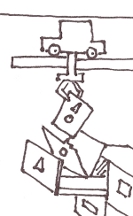 For more complex topics, it is necessary to place folders within folders. This further buries good content within the organizational structure. Issues with accessibility within one folder are at least doubly so with two. And of course this can continue with multiple nested folders.
For more complex topics, it is necessary to place folders within folders. This further buries good content within the organizational structure. Issues with accessibility within one folder are at least doubly so with two. And of course this can continue with multiple nested folders.
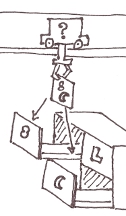 Another common occurrence when organizing complex topics is when content could be categorized under two, or more, headings.
Another common occurrence when organizing complex topics is when content could be categorized under two, or more, headings.
One could place copies of the content in each folder, but then what happens when something needs to be updated? Shortcuts are another possible work-around, but maintaining their relation maybe quickly become problematic.
Then there are the times where no existing category seems to capture what the content consists of. Or at least one can not find the category because searching necessitates traversing virtual space.
When creating new folders, one needs to be careful where to place folders so that they can be easily found. Also, when one is deep in the folder structure, one needs to be careful not to inadvertently create duplicate categories.
So for all these reasons, and may be few more you have run into, having content in folders can be a cumbersome.
 In contrast, by creating metadata concerning each file, or bit of content, and organizing the metadata, one can depend on more than just a hierarchy for organization. This may break away from the desktop metaphor and be new for those not used to “tagging”.
In contrast, by creating metadata concerning each file, or bit of content, and organizing the metadata, one can depend on more than just a hierarchy for organization. This may break away from the desktop metaphor and be new for those not used to “tagging”.
 One still needs to do work such as coming up with standard metadata to help categorize files as well as associate that information to each file.
One still needs to do work such as coming up with standard metadata to help categorize files as well as associate that information to each file.
However, you can associate more than one category to a file. The categories can be readily available from a menu with instruction, and need not be limited to what the operating system allows folders to be called.
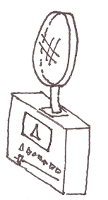 Of course this all cannot happen without additional help. Unlike files and folders, this type of organization of content is not often part of the operating system. It typically requires and application that will take the content and put it into a database. It would be retrieved that way as well.
Of course this all cannot happen without additional help. Unlike files and folders, this type of organization of content is not often part of the operating system. It typically requires and application that will take the content and put it into a database. It would be retrieved that way as well.
Instead of scouring through folders, one can use a query, or filtering tool to find bring up the documents from the metadata. The filter can be more complex than simply peeking into every folder, but take into account multiple parameters. For example, give me all documents with one category but not another.
Further, since a application is used to retrieve the data, it can help instruct the searcher on how to find what they are looking for.
I hope my cartoon, and this quick explanation of what it illustrates may be helpful. I am releasing it with a creative commons license so feel free to share and use.
See also my previous post discussing SharePoint’s Conceptual Leap which also deals with database organized, and created, content.

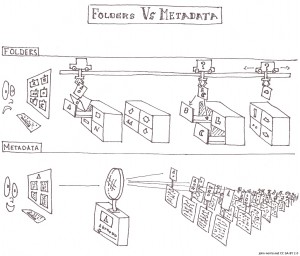

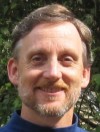

Hi John
I have many times explained the benefits of folders but this is the first time I have found and image that illustrates this so well.
Mostly I use the analogy of the Rubics cube where you can cut and dice flat data which you cant when it is held in folders – but people really are resistant to change aren’t they
I would like to request permission to use please the first image in an internal company communication that will fully acknowledge you and link to your site and to the related SP article
Thanks Guy
Hi Guy,
Thanks for the kind words. I know the struggle for sure. I sometimes like to talk about the common dilemma of a file you want to put into two folders.
The images are some of the most popular content on my site, so it must have struck a cord.
Please go right ahead and use. They are released under the Creative Commons Share Alike – By 2.0. My intention is for others share, remix, and get the word out – just let folks know where you got it from. (And it sounds like you are.)
Best of luck!